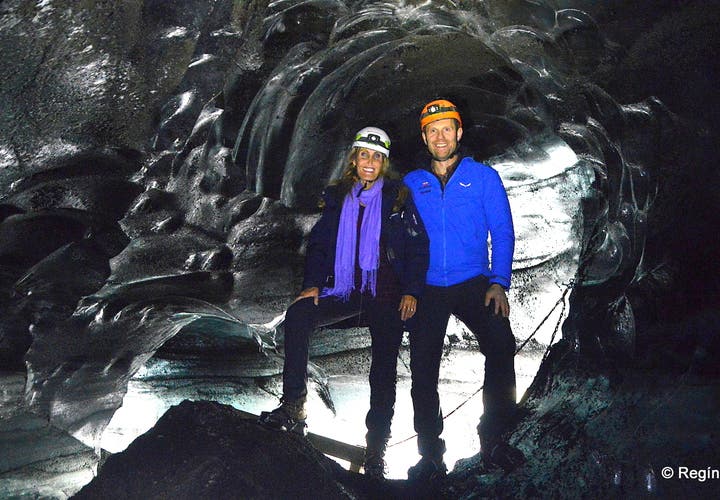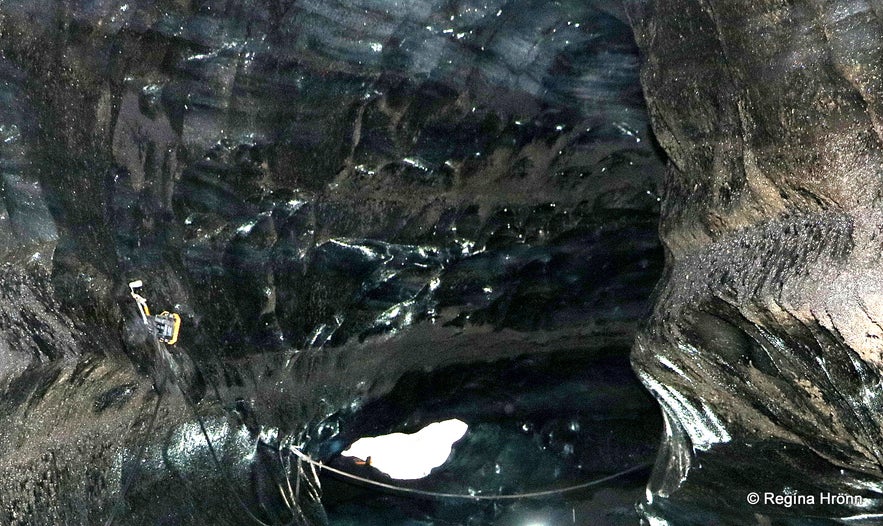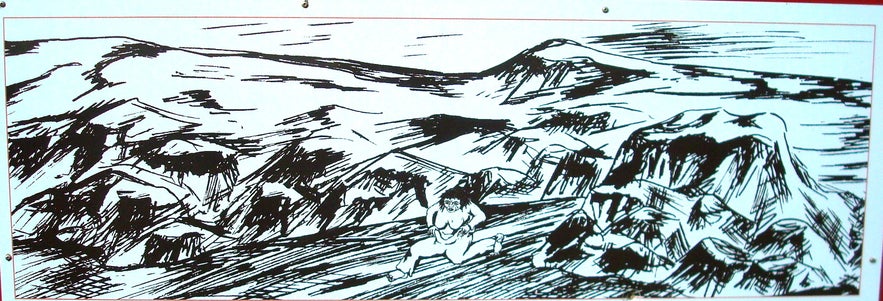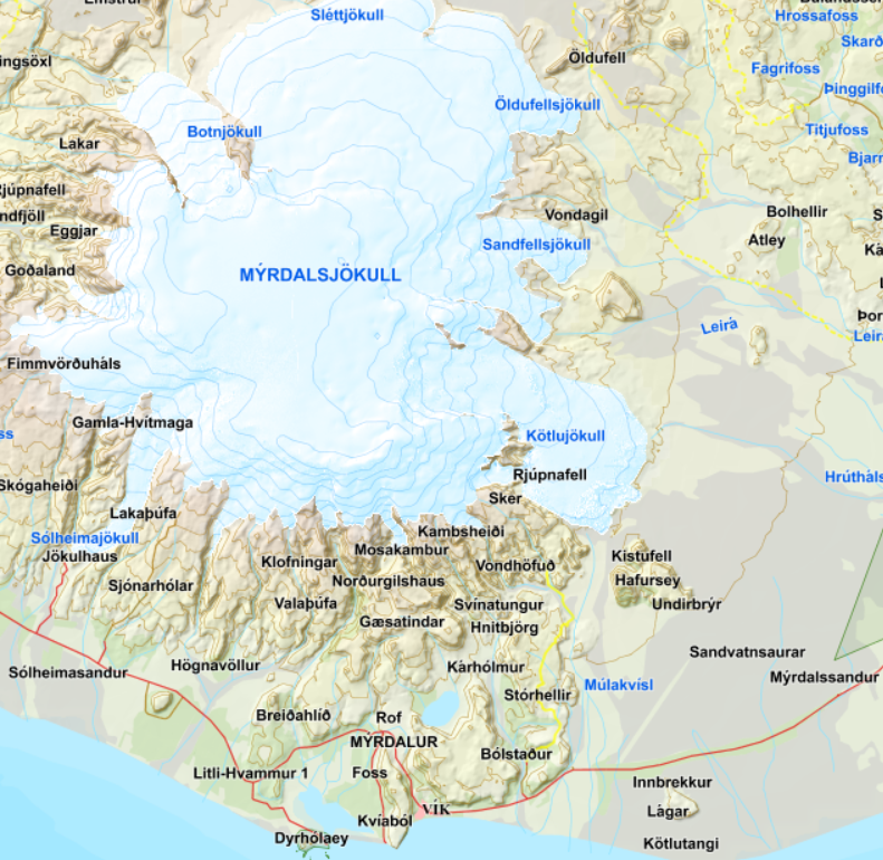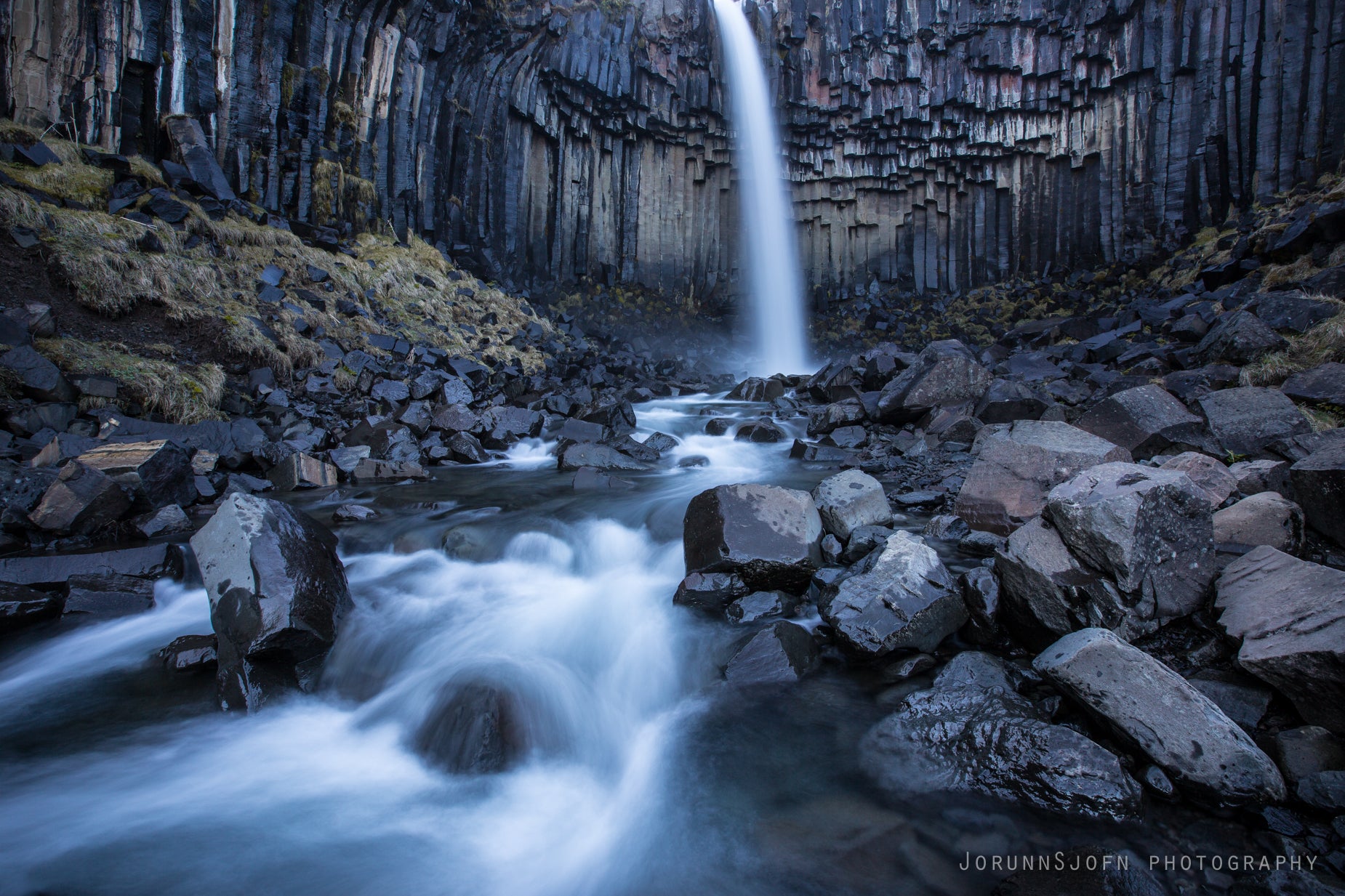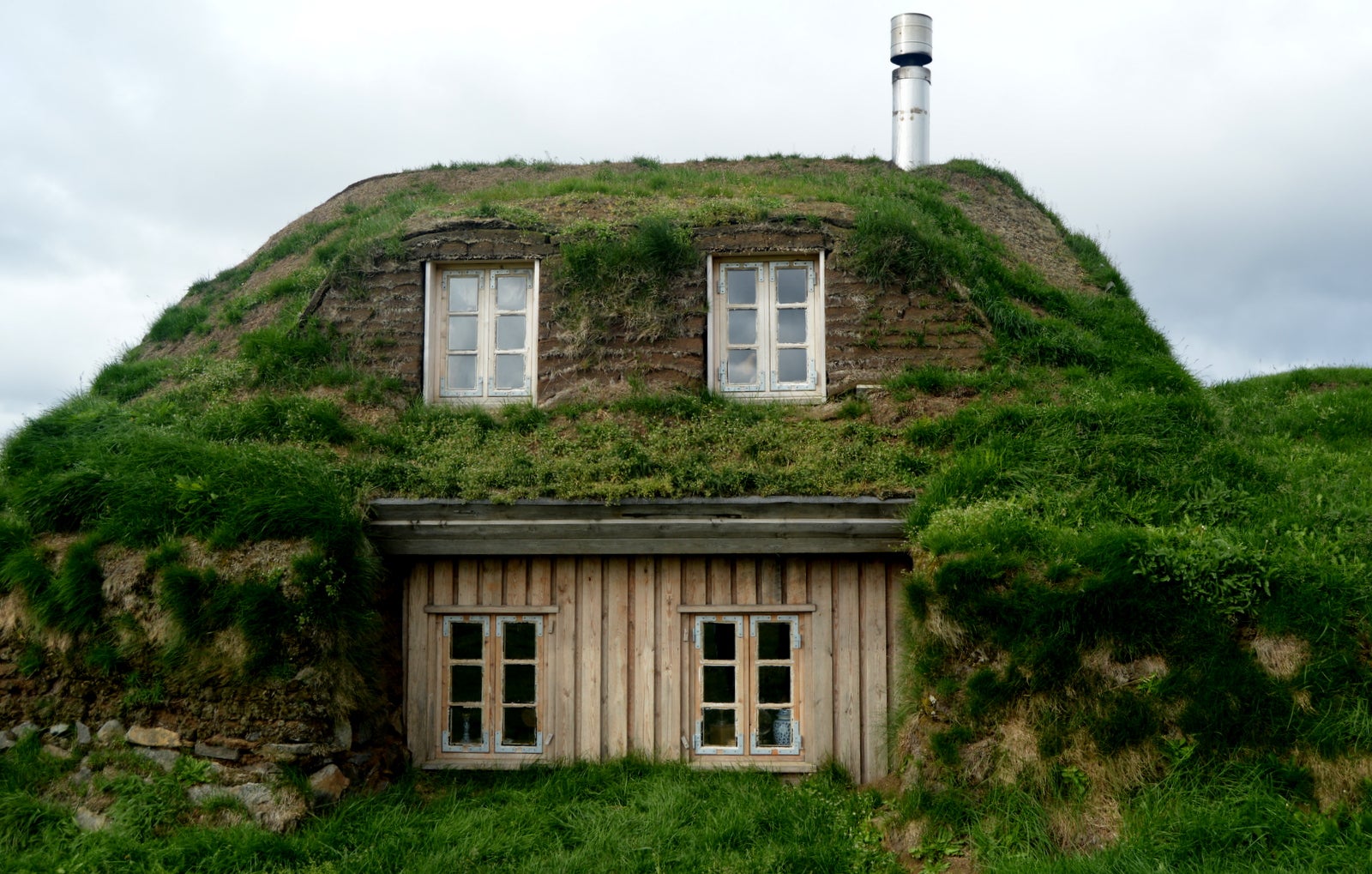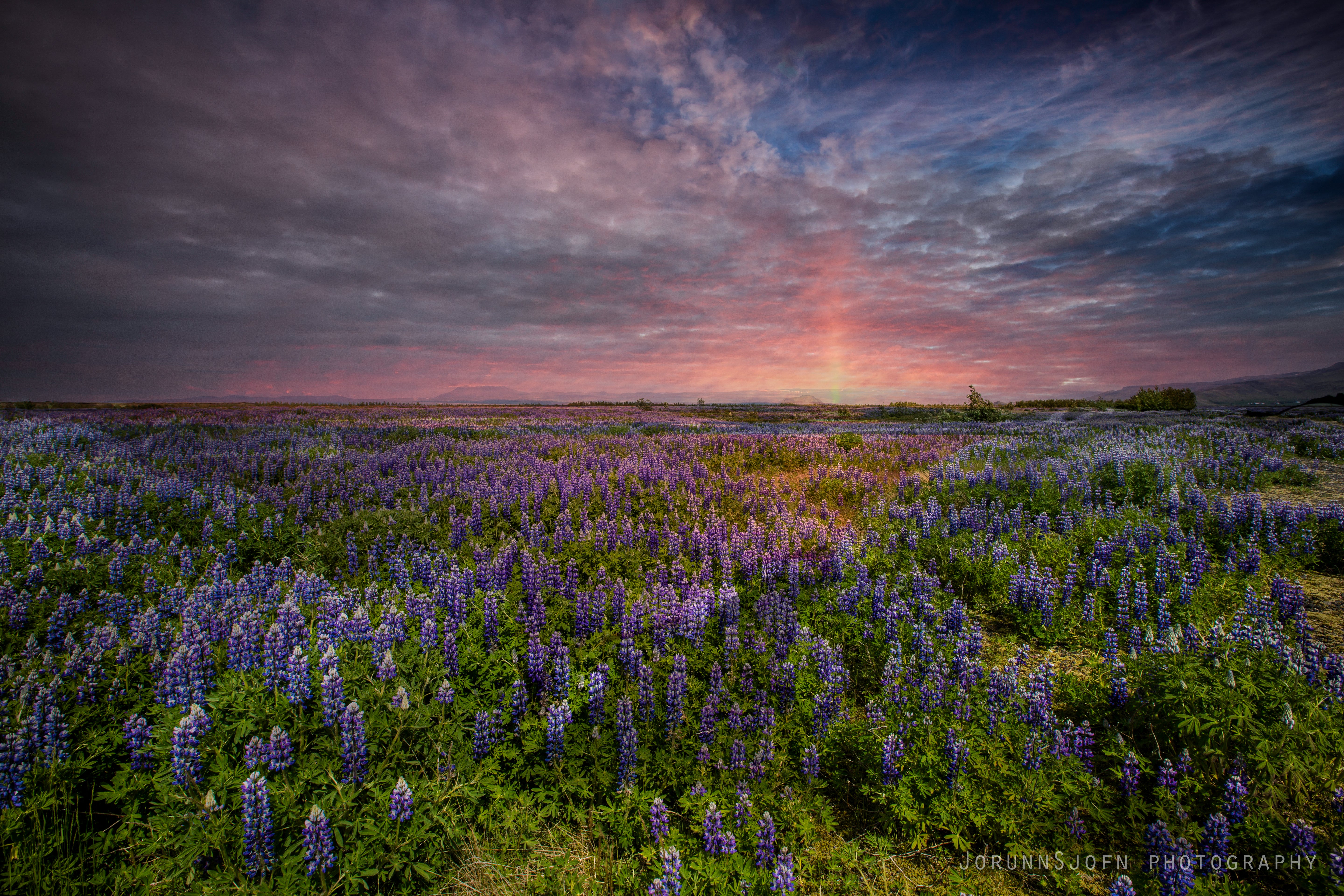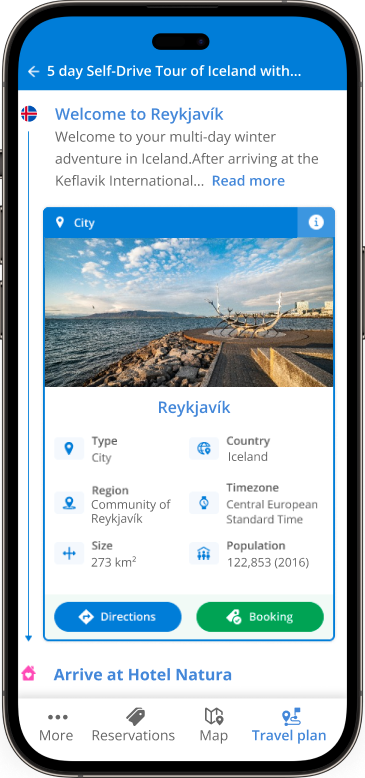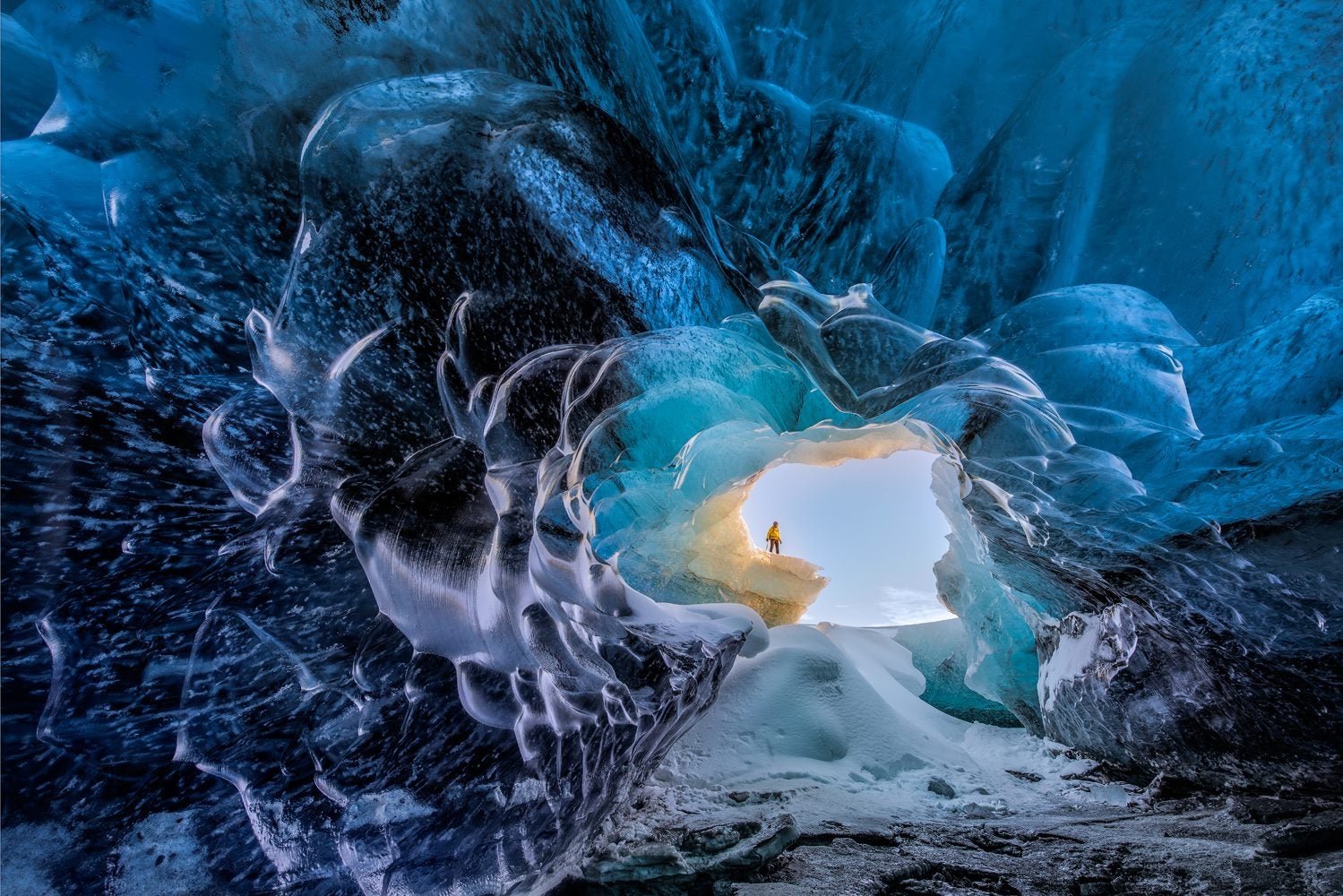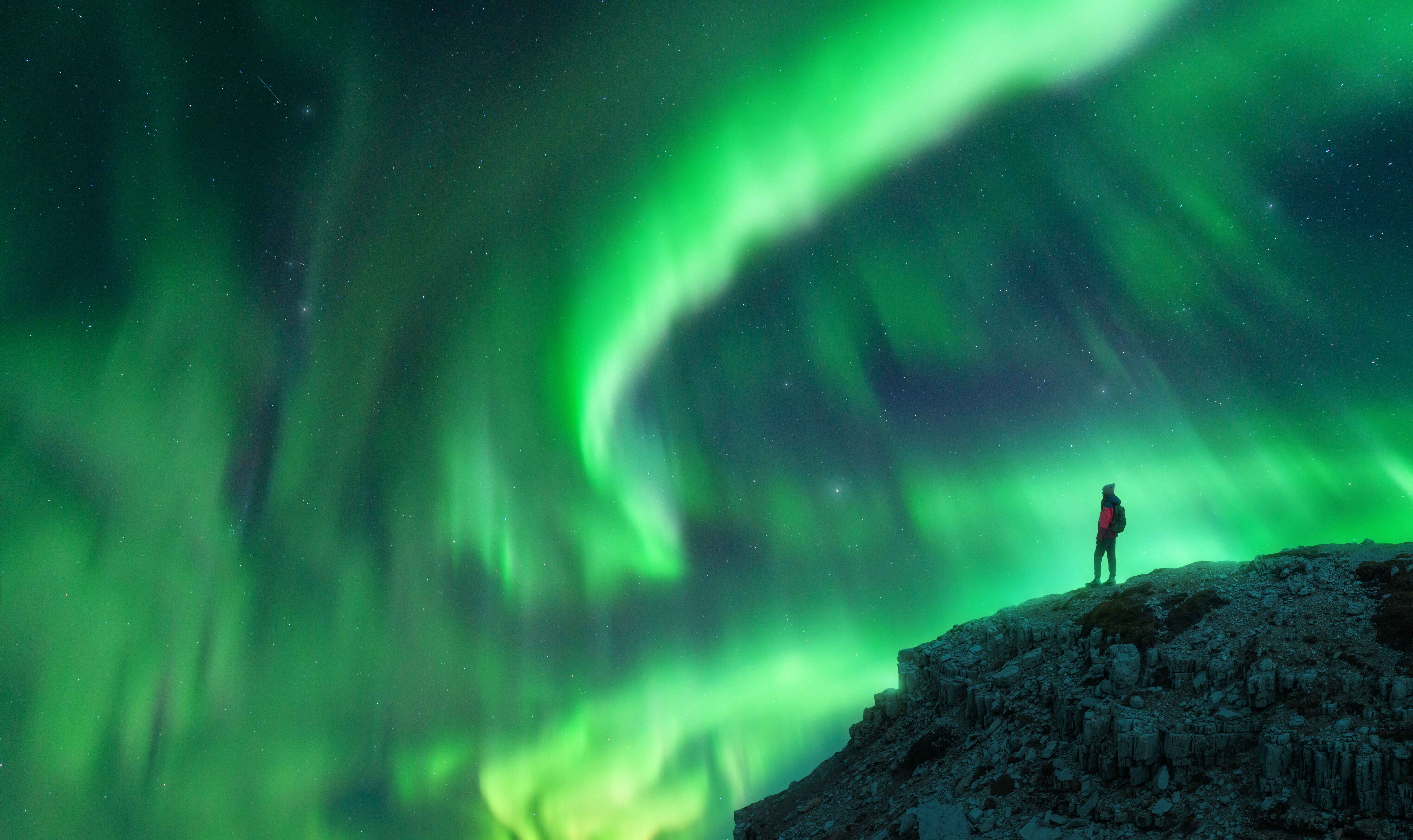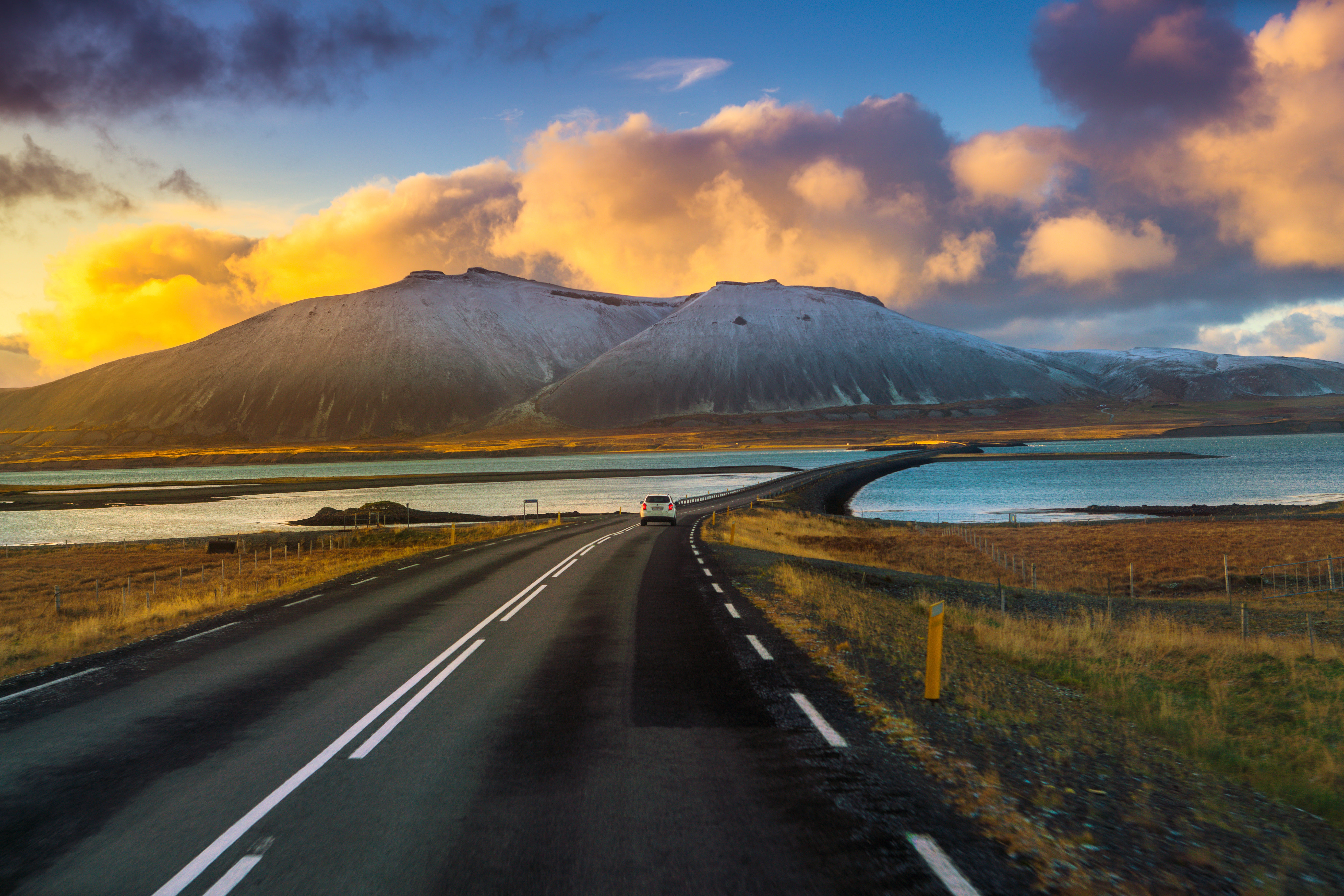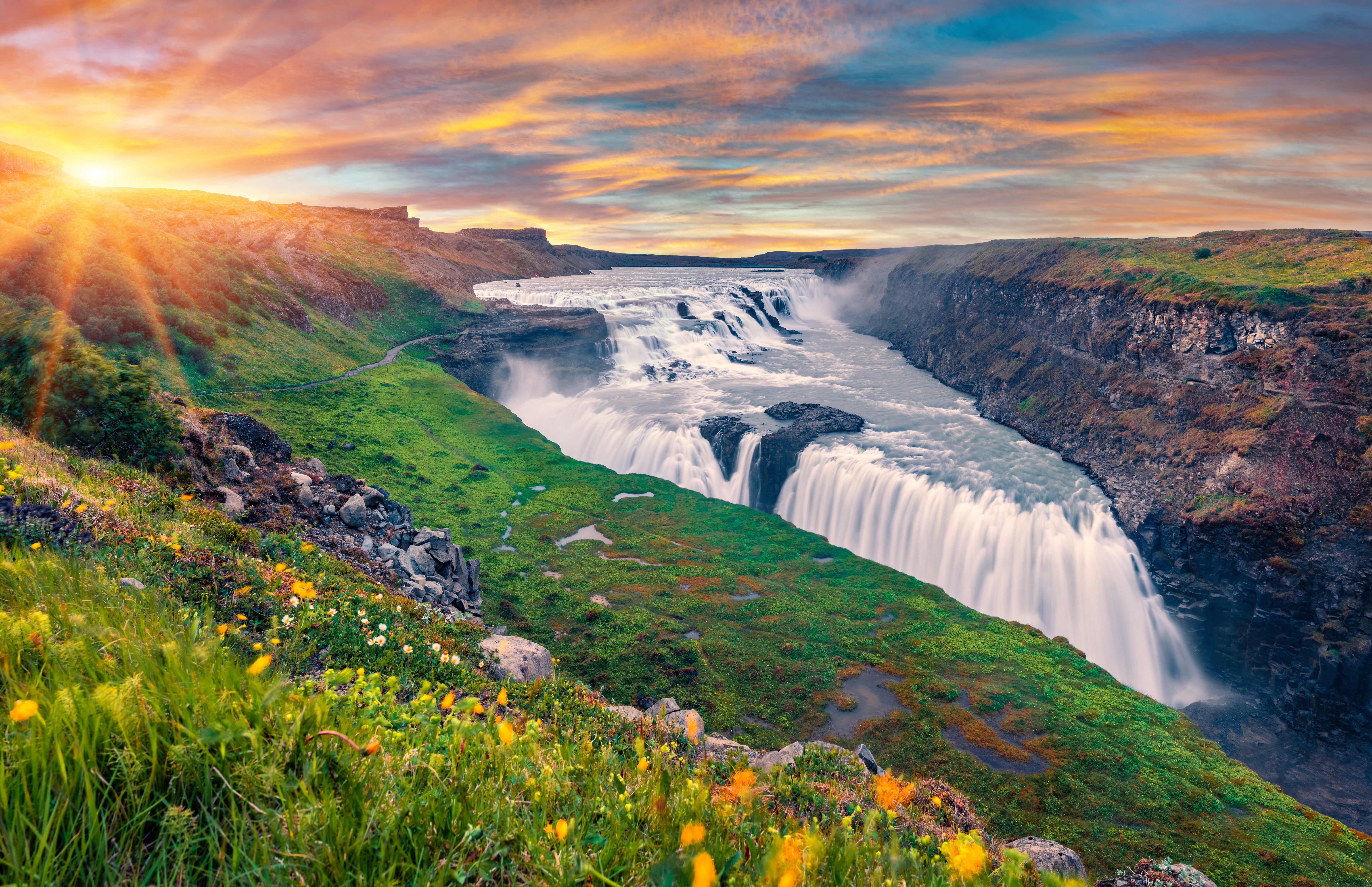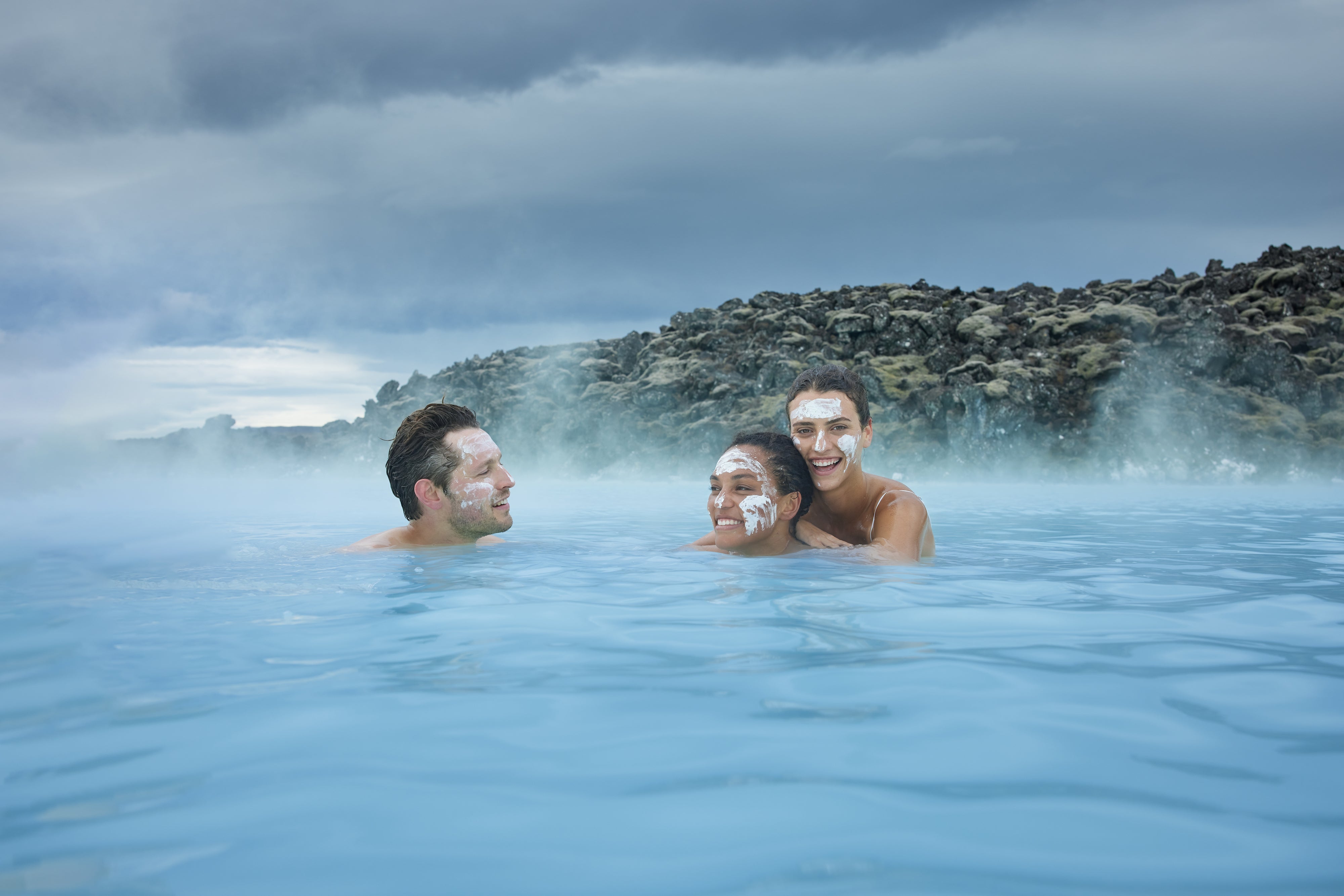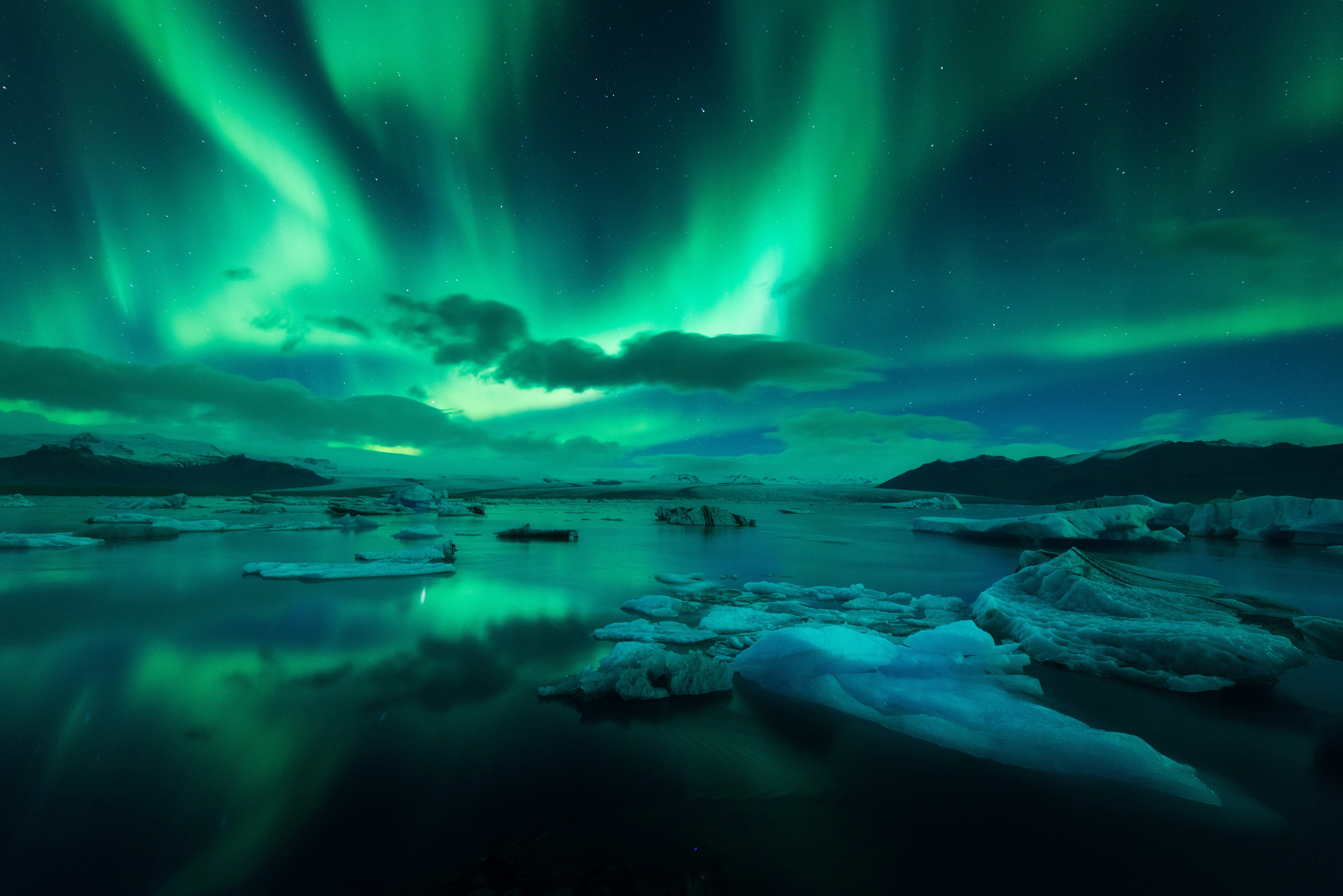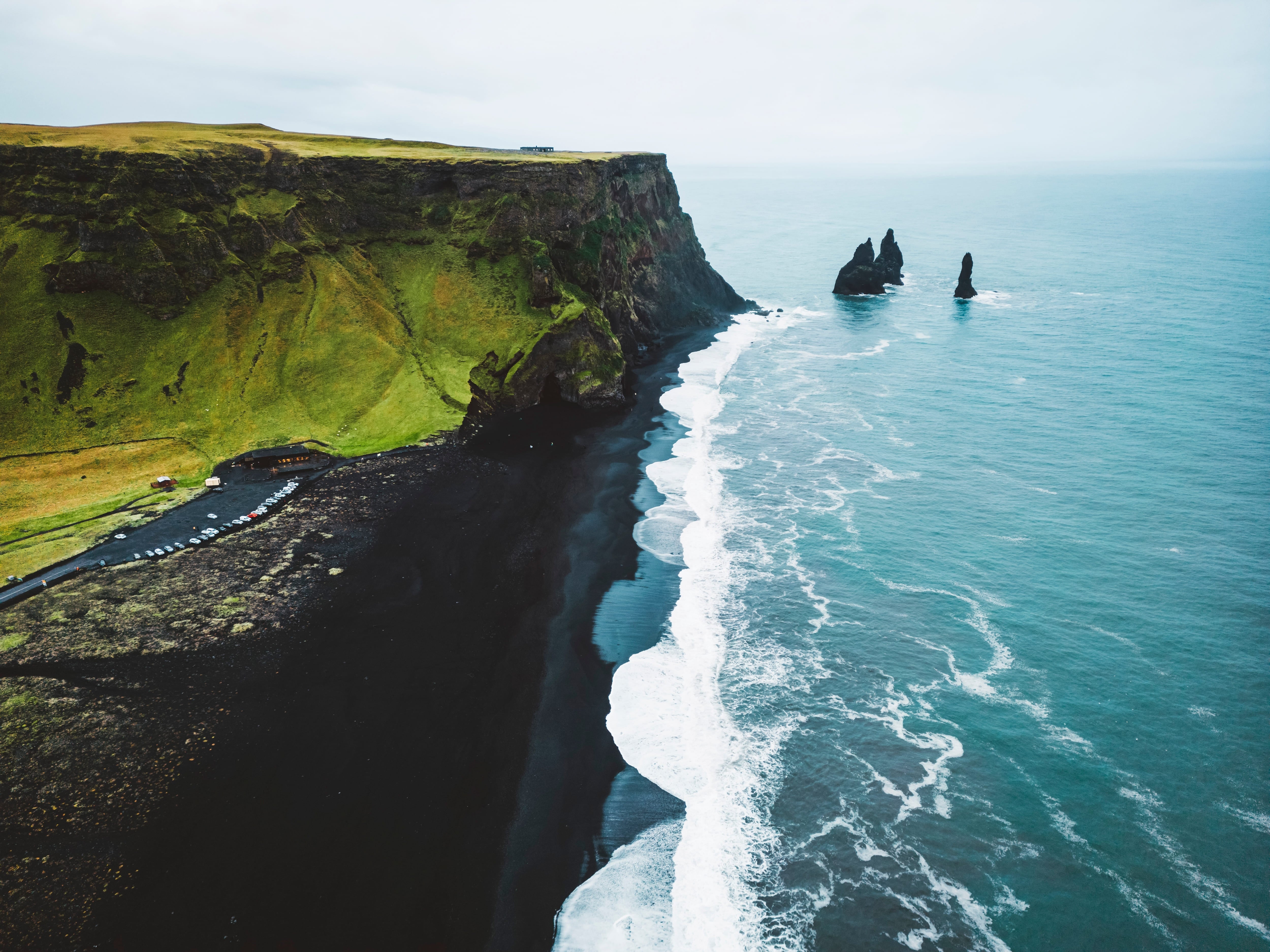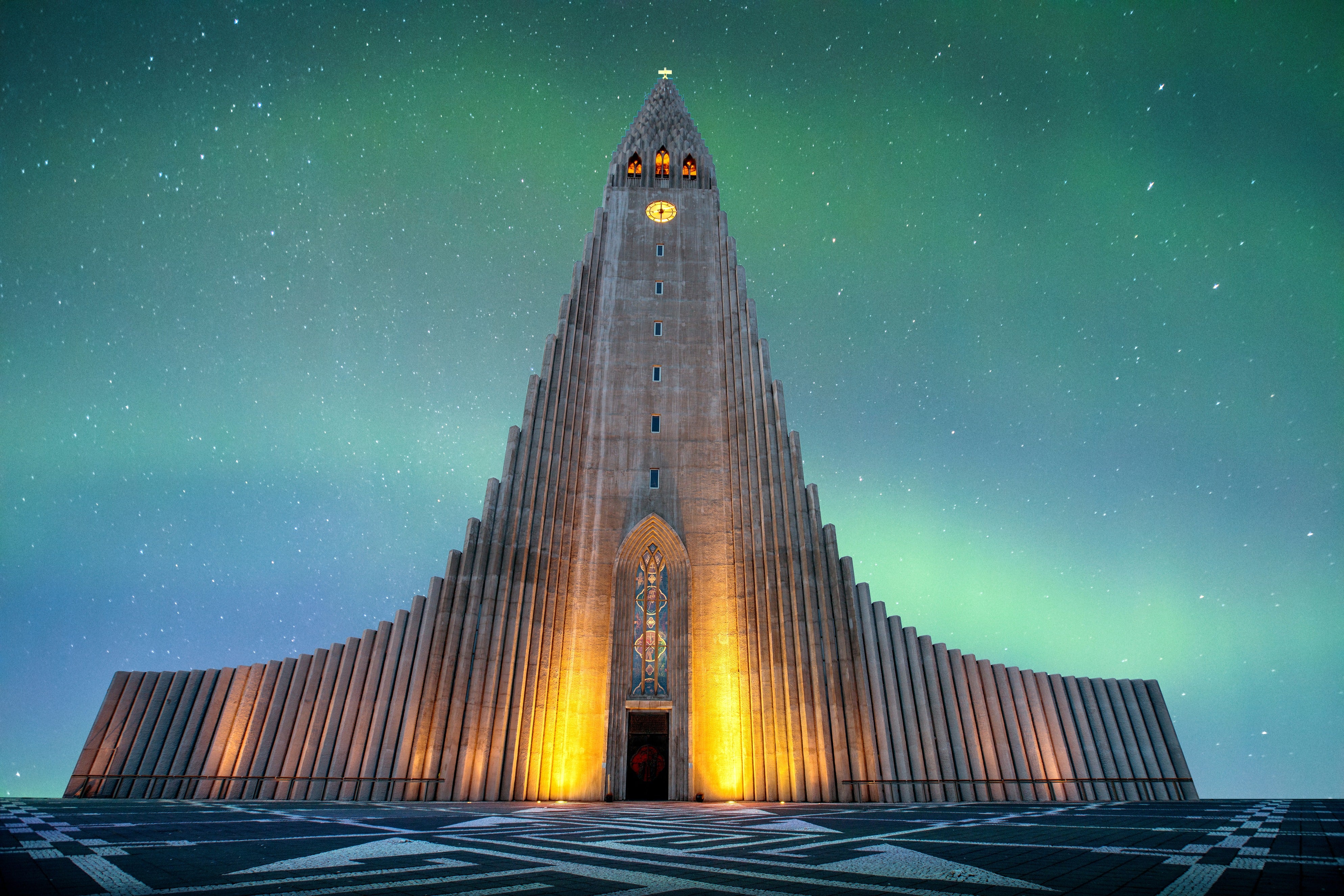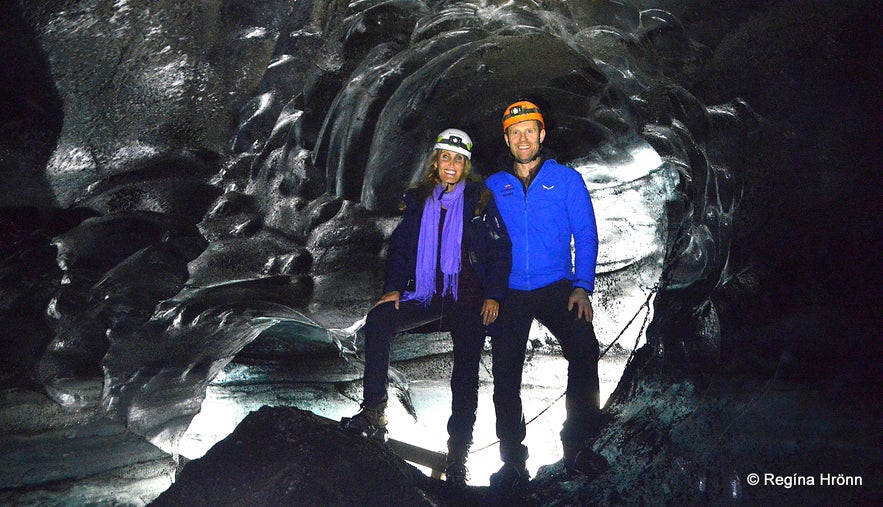
In my travel-blogs through the years I have written about my visits to a couple of seasonal ice caves in Iceland, which form in the wintertime in Vatnajökull, our largest glacier, and in 2018, I visited for the first time a spectacular ice cave close to Vík village in South Iceland.
It is called the Katla ice cave, and is located in the Kötlujökull glacier, a ruggedly beautiful icefall of Mýrdalsjökull glacier, Iceland's fourth largest glacier.
Here we are in the territory of the most dreaded volcano in Iceland - the subglacial Katla itself!
Top photo: inside the Katla ice cave with the glacier guide from Katlatrack

Inside Katla ice cave
It had been on my agenda for a year to visit this ice cave and when some of the staff of Guide to Iceland was invited to visit the ice cave with the company Katlatrack I was invited to join them.
We drove from Reykjavík city to the scenic little village of Vík in Mýrdalur in South Iceland.
The Katlatrack glacier guides picked us up in their super jeeps at their meeting point at Vík (by the N1 gas station) right by ring-road 1.

The meeting point at Vík
The ice cave is a 45-minute drive north of Vík through black volcanic sand plains from previous eruptions of the still active Katla volcano (i.e. we have been waiting for it to erupt).
Our guide blasted Highway to Hell on the radio, which I found to be both hilarious and fitting for where we were going - towards the notorious Katla, which most Icelanders are afraid of.
Another very active volcano in Iceland, Mt. Hekla, earned the nickname Gateway to Hell a millennium ago. When Mt. Hekla erupts we call it a tourist eruption - when Mt. Katla erupts we call it a cataclysm!
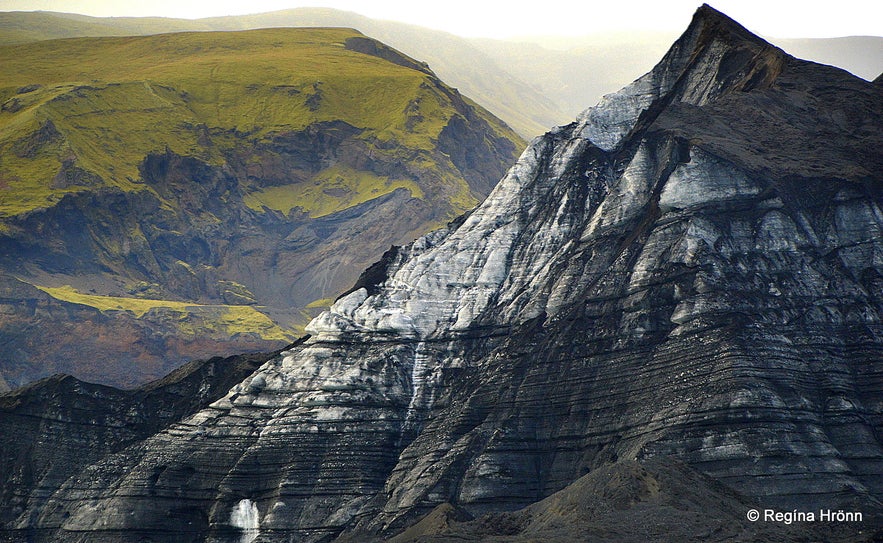
Parts of Kötlujökull glacier
That is why we Icelanders fear it, not that many of us have witnessed it erupting though, as the last eruption took place in 1918. But we have heard stories...
The ride to the glacier is very scenic, through a ruggedly beautiful landscape with extraordinary contrasts.
The pitch-black lava sand and the green mountains created a spectacular scene. Soon it was to become even more spectacular.
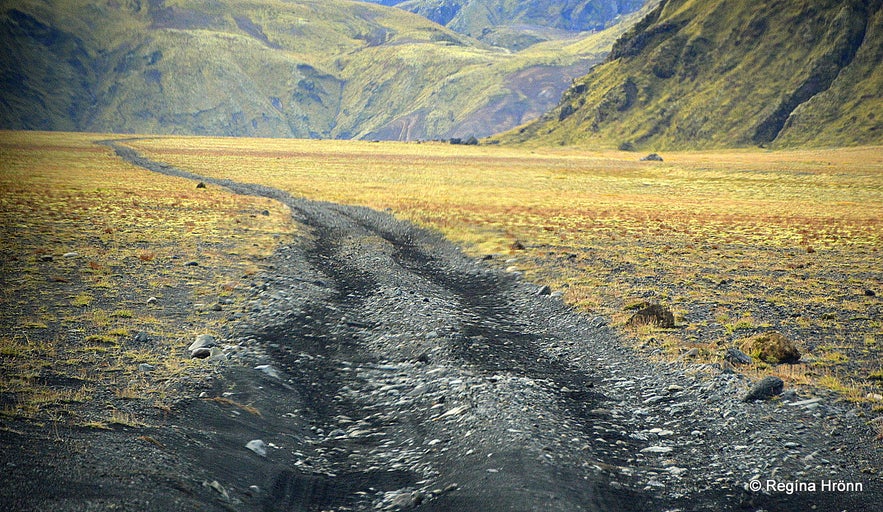
The track leading to the Katla glacier
For such sandy roads, the driver lets some air out of the super-jeep tires (to around 12-16 psi) as it gives the tires a wider grip on the sand. The same is done when driving on glaciers in Iceland.
I tell you this so that you know what is happening on your upcoming tour when the driver suddenly disappears and starts fiddling with the tires ;)
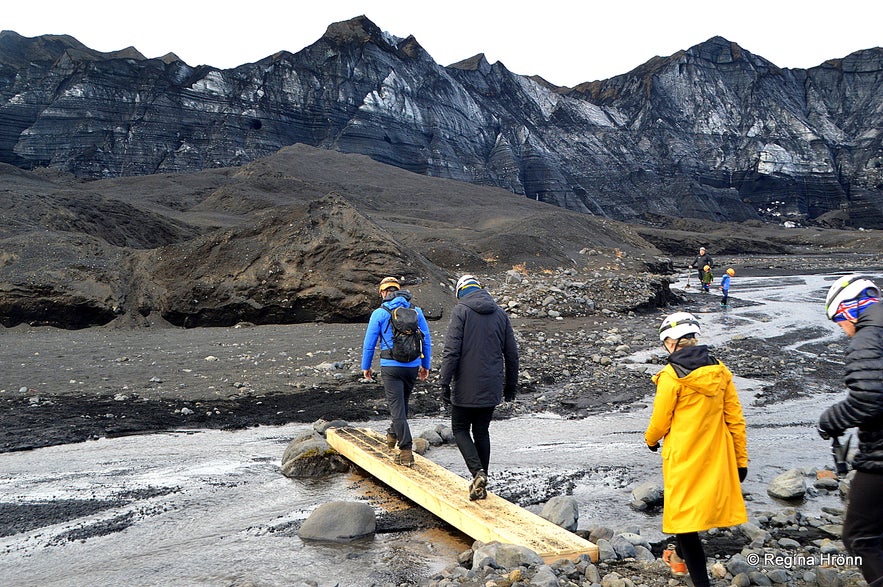
On the way to the ice cave
Once we reached the Mýrdalsjökull glacier the glacier guides provided us with sturdy glacier crampons and helmets with headlights.
One has got to appreciate the glacier crampons, they give us such good grips on the glacier hikes and inside the ice caves.
We now followed the guide on a short hike to the black icefall Kötlujökull - the Katla glacier. It is an easy hike, only 5-7 minutes or so. We crossed a few creeks, with meltwater from the glacier, and in some places, the glacier guides had fitted planks over the creeks to make it easier for us to cross.
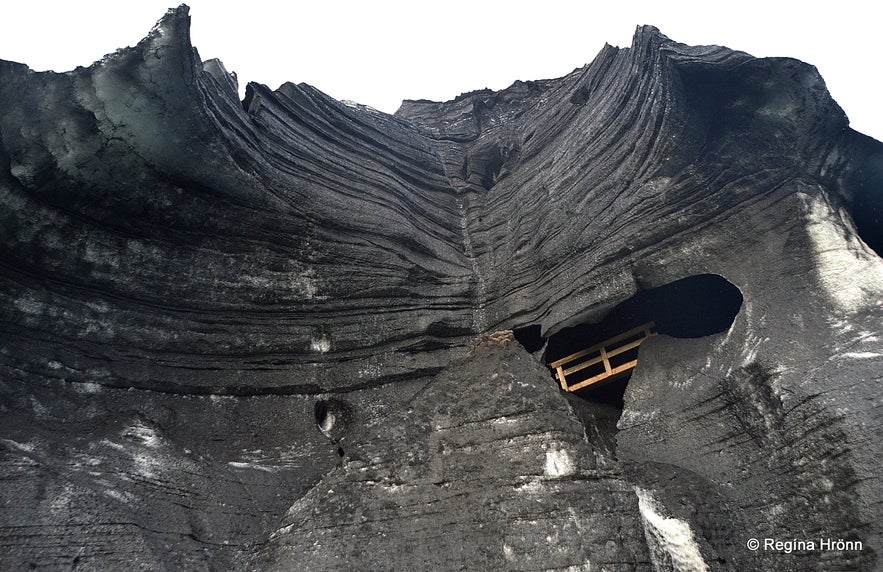
The entrance to the Katla ice-cave
When we reached the ice cave, I immediately thought to myself that it looked like a scene out of Game of Thrones or Lord of the Rings. I was in awe just seeing the entrance to the cave. Don't you agree with me?
See also my travel-blog: The Extraordinary Game of Thrones Locations I have visited on my Travels in Iceland
The glacier guides have carved steps into the glacier to make it easier to ascend into the ice cave. You also have ropes to hold onto so it is easy to enter the cave.
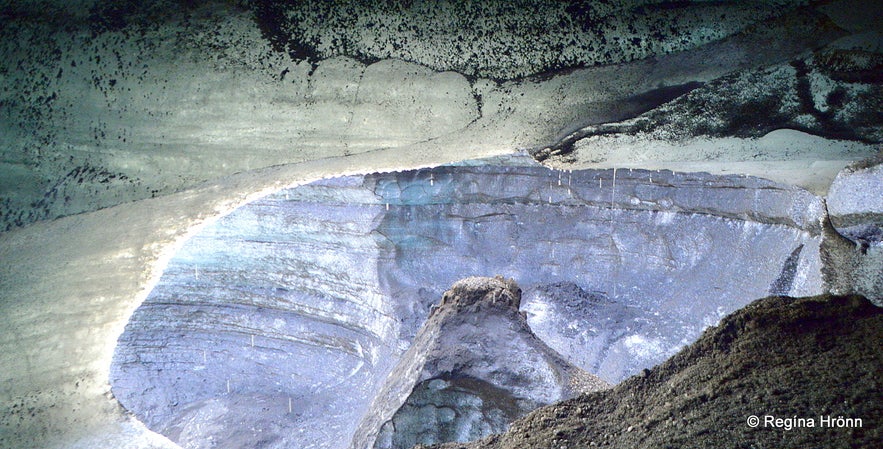
Inside Katla ice cave looking out at the blue ice
Once inside you will have ropes and small bridges for your aid. Be careful here though and watch your step.
I have been way too daring while visiting the ice caves; carrying 2 heavy cameras and taking photos left and right.
I even turned around one time to take a photo of the group while we were holding a rope and timidly walking inside the Katla ice cave in the darkness. This is not recommended, even though I think that the photo I took is awesome.
 I turned around in the darkness inside the ice cave and took this photo using flash that lit up the group
I turned around in the darkness inside the ice cave and took this photo using flash that lit up the group
These beautiful ice caves are formed in the glacier tongues when water from the melting glacier finds its way and carves an opening in the ice. Thus enabling us to have a rare peek inside.
And in this instance to walk through a black and blue ice tunnel with beautiful shiny ice formations.
I love blue ice, which is the oldest part of the glacier. Why it is blue is explained in detail by Nanna in her fantastic article Ice Caves in Iceland - the Ultimate Guide. It is an essential read about glaciers and ice caves in Iceland in my opinion.
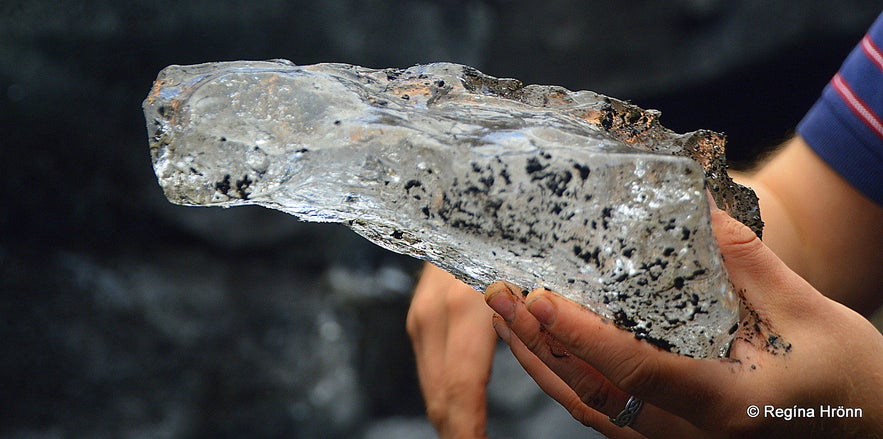
Our glacier guide picked up a piece of melting ice, shook it, and showed us some air bubbles trapped inside the ice.
Inside the ice cave, you will see pitch black ash from different volcanic eruptions of Katla volcano through the centuries - ash which has been pressed into the ice and has never been seen before.
Since the Vikings settled Iceland back in 874 (give or take a few years) Katla has erupted some 20 times with the last big eruption taking place in 1918.
So it must be due to erupt if there is a pattern to its eruptions.
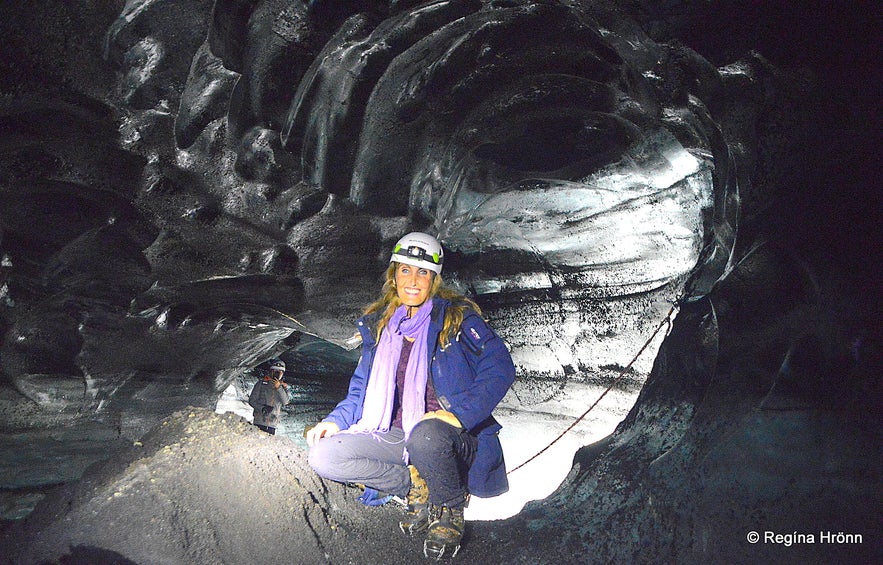
Inside Katla ice cave
The year of the last eruption in Katla, 1918, was quite an annus horribilis for Icelanders as it gave us an extremely cold winter, referred to as Frostaveturinn mikli - the Winter of the extreme frost - with 27 polar bears from Greenland coming ashore!
At the same time, the Spanish flu invaded Iceland. I as an Icelander was in awe and felt like I was walking through a tunnel of Iceland's history when I walked through the ice cave looking at the old ash from the Katla eruptions.
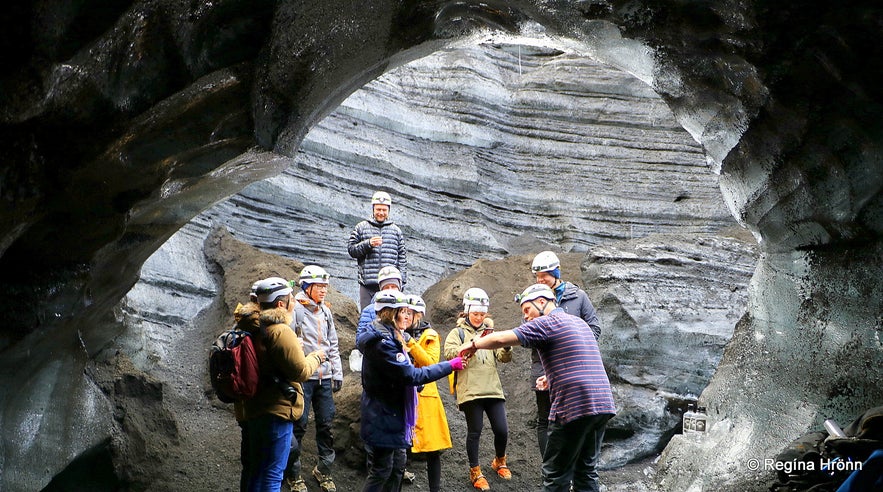
Drinking the glacier - Icelandic Brennivín on the rocks - with ancient ice from the glacier
When we reached the end of the ice cave we came out through another opening - and were greeted with a refreshing Icelandic Brennivín schnapps on the rocks!
Only the ice was age-old ice from the Kötlujökull glacier! Those who didn't want alcohol were offered water on the rocks.
I found it amazing being able to drink a toast to such forces of nature and somehow on returning through the ice cave I stepped more lightly and fearlessly. Maybe it was just the alcohol that went straight to my head ;)
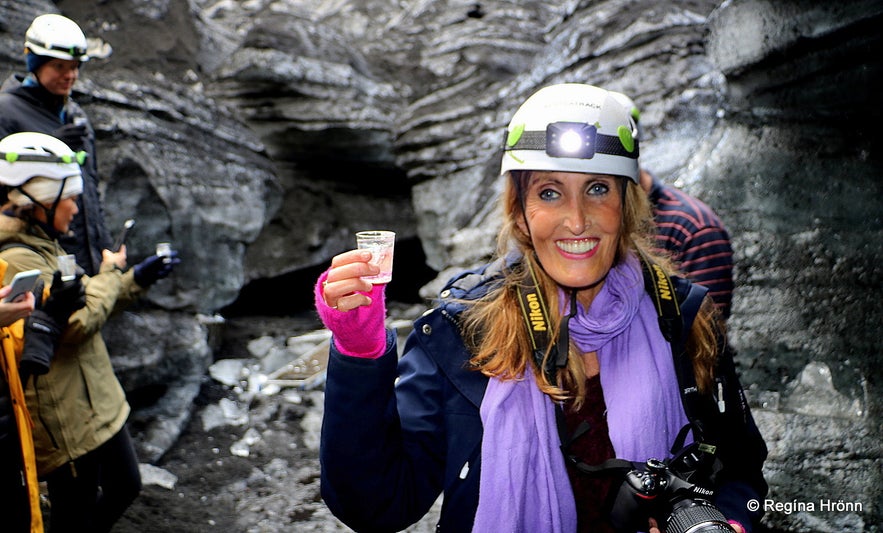
Cheers!
We spent an hour by the ice cave giving us ample time to take photos of every angle of the cave. And you can take some spectacular photos of the ice caves.
My amateur photos don't even begin to show what professional photos can look like.
If you have a yellow coat then I would advise you to wear it during your visit to Katla ice cave. I wore my blue parka but noticed that the best photos were of my fellow travelers who were wearing yellow. It makes you pop out of the photo.

Yellow color stands out when visiting the ice caves
I didn't know whether to use the flash or not in the ice cave, so I took photos left and right with flash and without flash to see which ones would turn out better.
The photos without the flash came out bluer, but with the flash, the ice lit up.
Most of my photos in this travel-blog are taken with flash. The flash, on the other hand, lights up the ash as well and makes it look brownish.
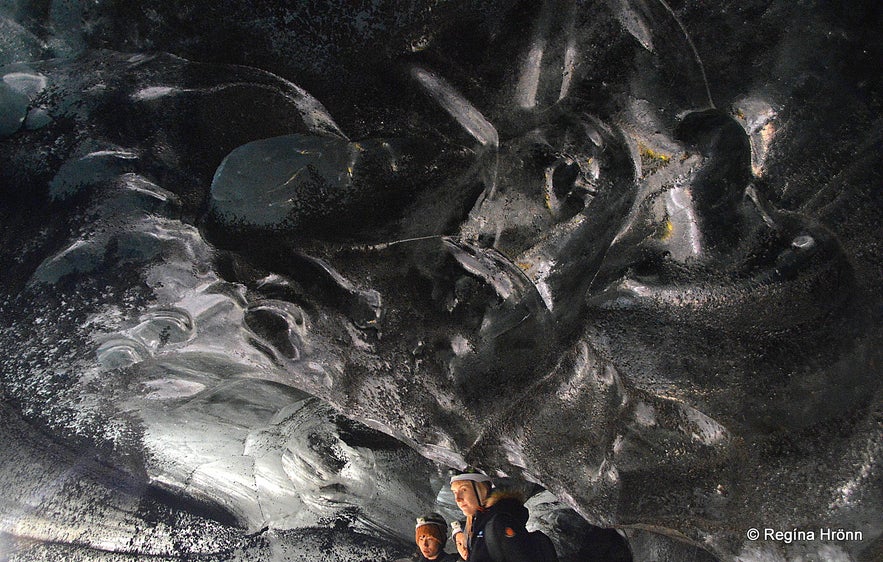
The staff of Guide to Iceland taking in the beauty of the ice cave
The glaciers are constantly moving so the ice caves change every year.
In previous travel blogs, I have shown you my visits to the seasonal crystal ice caves in Breiðamerkurjökull and Fláajökull glaciers, where the ice was blue and sparkling on the days I visited them on a cold day in January a couple of years ago.
Each time you visit the ice caves they will look different, so the photos I show you here are just what they looked like on the day of my visits.
You can see in the video I took what the Katla ice cave looked like in 2021
You can see a selection of good photos of the ice caves at Katlatrack.
The seasonal ice caves are open from the beginning of November until the end of March each year and can be visited when the weather permits. We never know though if or where they are going to form.
And they cannot be entered in the summertime, that is way too dangerous. Apart from Kötluhellir - the Katla ice cave, it can be entered all year round with experienced ice cave guides.

Looking out from the Katla ice
Some years the most beautiful ice caves form and are never to be seen again. And new ones appear.
So it is always a new and exciting experience visiting an ice cave.
Icefalls move under their weight and calve, so the glaciers and natural glacial ice caves cannot be visited without a trained and experienced glacier guide, I cannot reiterate enough how important this is.
We were in super good hands with the Katlatrack glacier guides.

By the entrance to the Katla ice cave :)
The trained glacier guides always check out the condition of the ice caves before they enter them with a group. Safety is of the utmost importance in ice caves.
How the volcano Katla got its name
Inside Katla ice cave
Some of our volcanoes have female names, as we all know what we women can be like when we erupt ;) We fear Katla the most and Icelandic folklore tells us how Katla got its name.
I found the story in Þjóðsögur Jóns Árnasonar - the Collection of Folklore of Jón Árnason, which is a compilation of folklores in five volumes, and translated it into English:
"It happened once upon a time that at Þykkvabæjarklaustur monastery an abbot living at the monastery had a cook called Katla.
She was a bad-tempered woman, and she owned trousers, which were of the nature that anybody who put them on could run forever without feeling tired.
Katla used these trousers when she needed to run.
I cropped the photo of Katla running in her trousers from the information sign in Katla Geopark
People were afraid of Katla's witchcraft and her temperament and even the abbot feared Katla. At the monastery, there was a shepherd by the name of Barði.
Katla often scolded him severely if any of the sheep he was herding went missing.
One autumn the abbot of the monastery went to a feast and Katla went with him. Barði, the shepherd, was ordered to round up all of the sheep before their return. But he was not able to track down all of the sheep.
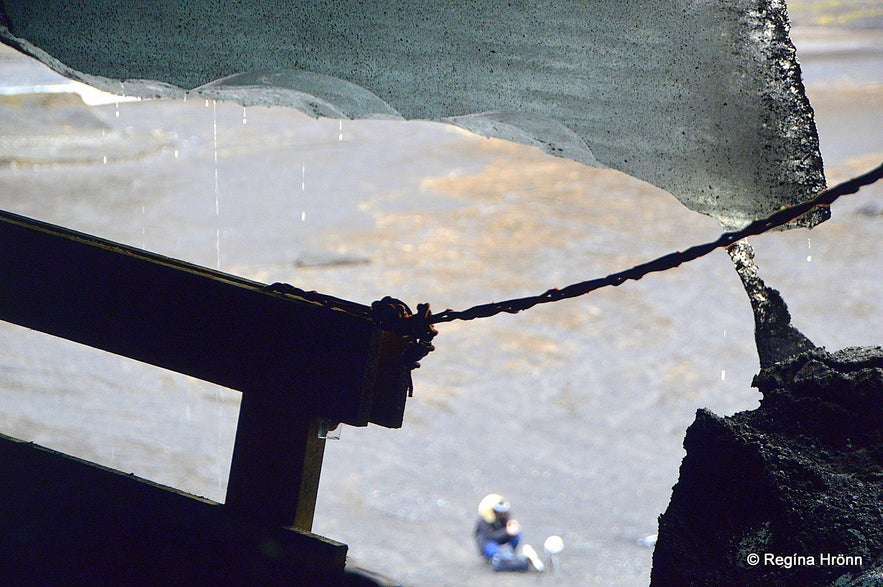
Inside the Katla ice cave looking out at the photographer Iurie Belegurschi preparing his drone
He decided to put on Katla's trousers and wearing these trousers, he was able to run and locate all of the sheep.
When Katla returned home from the feast she noticed that Barði had taken her trousers! She then took Barði and drowned him in a barrel of whey acid and left him there.
Nobody knew where Barði had disappeared to, but later on that same winter the whey acid in the barrel was little by little running out, and people could hear Katla uttering these words: "Senn bryddir á Barða" meaning "Soon Barði will reappear".

The view from Katla ice cave
Katla realized that her evil act would be uncovered and that she was bound to be punished.
She grabbed her trousers, ran out of the monastery, and headed northwest towards the Mýrdalsjökull glacier, plunged into it and was never to be seen again.
But shortly after this happened a flood burst from the glacier and headed in the direction of the monastery and Álftaver.

The ice is blue, grey, and brown depending on how much ash there is trapped inside it
From then on people believed that Katla was using her witchcraft and causing the floods.
The rift was from then on named Kötlugjá or the Rift of Katla, and the area, which the flood had destroyed, was called Kötlusandur or the Sandplains of Katla".
(Translated into English from Þjóðsögur Jóns Árnasonar - the Collection of Folklore of Jón Árnason - volume 1, pages 175-176)
Find more folklore on Katla and the glacier bursts in my travel blog about the notorious Katla
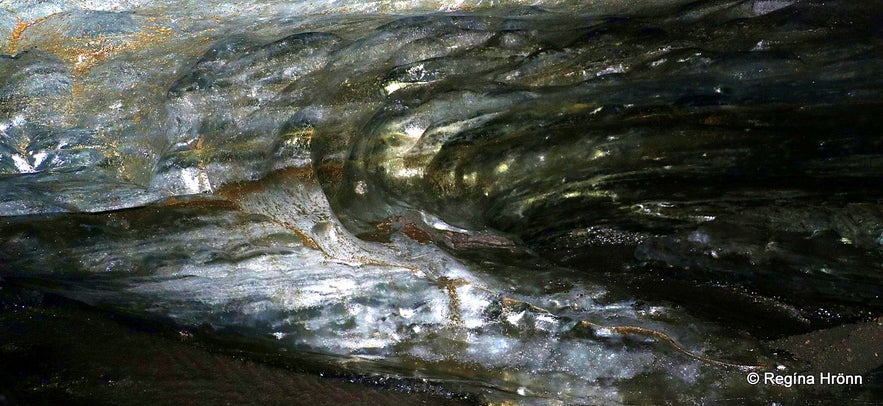 The ash trapped inside the ice in the Katla ice cave looks like gold all lit up by the flash
The ash trapped inside the ice in the Katla ice cave looks like gold all lit up by the flash
In the photo below you will see parts of the beautiful Hafursey opposite the ice cave.
Hafursey is a palagonite mountain standing tall on the black sandplains of Mýrdalssandur. It looked beautiful in the sunshine.
During one of the Katla eruptions, the glacial flood burst through a gorge in Hafursey on its way to the sea.
Read much more about the glacial floods in my travel-blog on Katla Volcano & Kötlutangi Spit
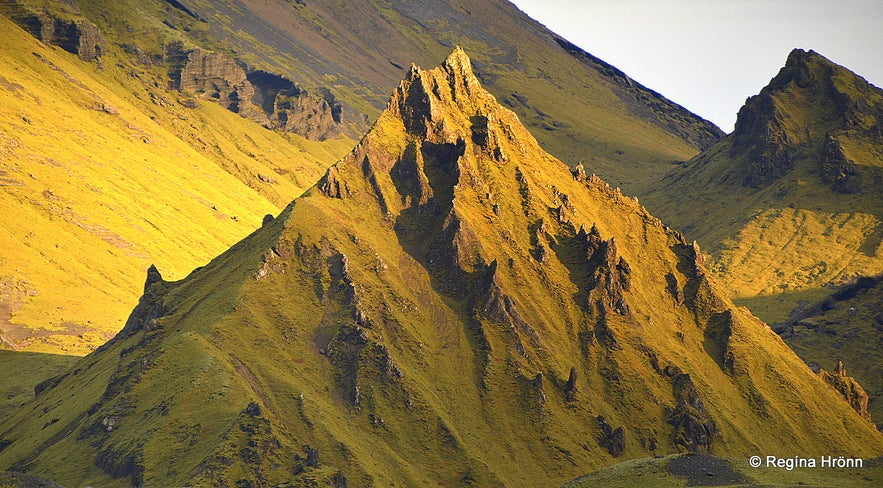
Mt. Hafursey
In the Katla eruption in 1755, some 6 men were able to seek shelter in a cave in Hafursey with the glacier burst roaring outside.
In my abovementioned travel-blog, you can read several stories about what happened to the inhabitants of this area during the glacier bursts.
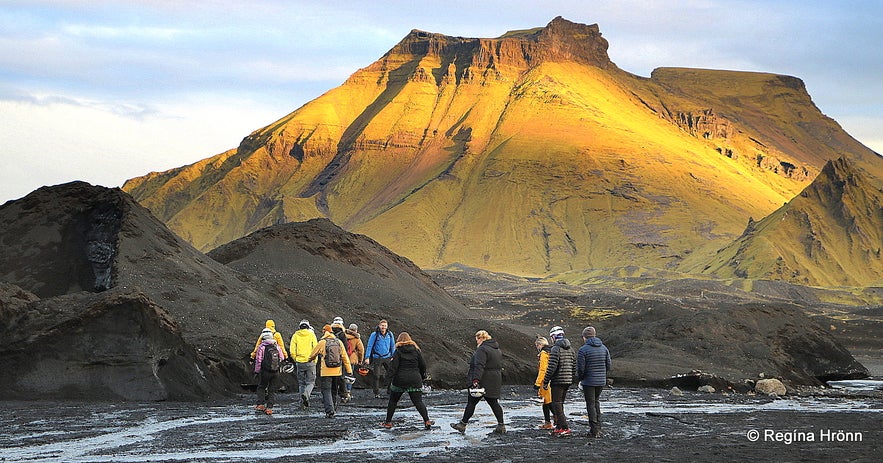
Returning to the jeeps after the thrilling experience of visiting an ice cave
The owners of this area were the same as of the historical Hjörleifshöfði, which I have told you about in other travel-blogs.
They gracefully allowed a few tour operators to offer guided tours into the Katla ice cave to show us its beauty.
Under the conditions though that it be tastefully done and that it will never become overly crowded and touristy. So that is what we can count on when visiting Katla ice cave :)
Since I last visited Katla ice cave back in 2021, Hjörleifshöfði has been sold.
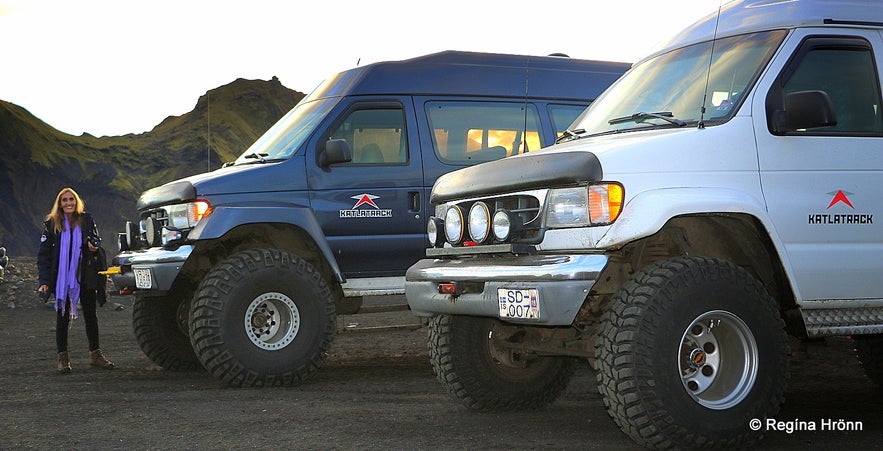
I love travelling in super jeeps and had a field day in the Katlatrack super jeeps ;)
Tours available by Katlatrack:
Katla Ice Cave Tour | Departure From Vík - 4 hours
Fast Track Ice Caving Tour from Vík in South Iceland - 3 hours
Private 8-Hour South Coast Super Jeep Tour with Ice-Caving and Optional Reykjavik Transfers
The Hidden Mountains - Super Jeep Tour from Vík which takes you f.ex. to Þakgil Canyon which I love
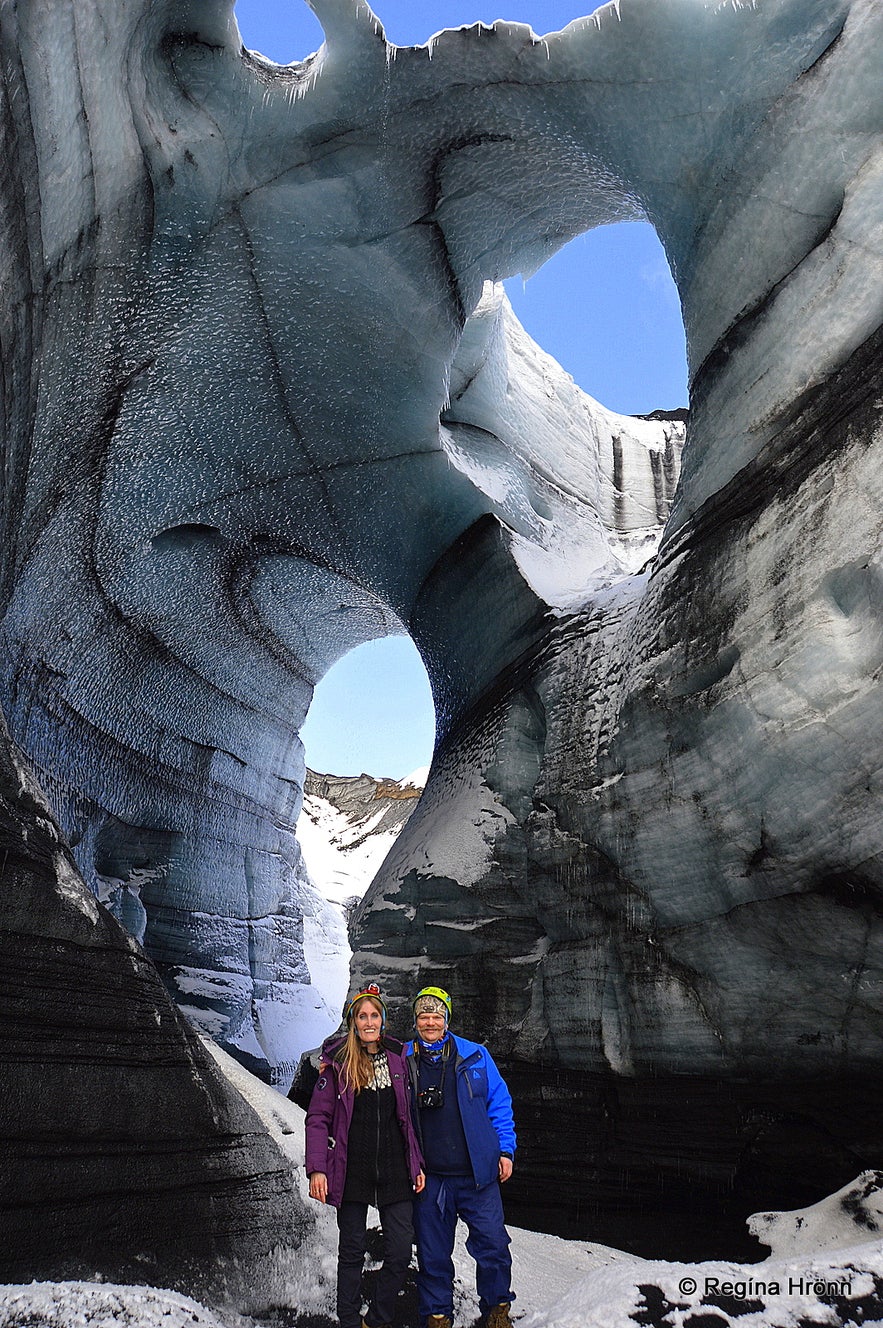
Katla ice cave in 2021 - the one we visited earlier had collapsed and this one was discovered close by
If you decide to visit the Katla ice cave from Vík, you can rent a car in Reykjavík and drive to Vík in a couple of hours. It is located 187 km away from Reykjavík with many beautiful stops on the way.
If you choose to be picked up in Reykjavík, then Katlatrack will stop by many of the sights on the south coast on the way to Vík.
They will then continue driving up to the Kötlujökull glacier through the vast Mýrdalssandur sand plains.
Map from the Icelandic Land Survey
Sólheimajökull is another glacial tongue stretching out from Mýrdalsjökull glacier.
Glacier hikes are very popular on Sólheimajökull, which also sports a small glacial lagoon. You can see what a glacier hike is like in my travel blog:
Glacier Hike & Ice Climbing on Sólheimajökull glacier in South Iceland
Have a fantastic time visiting the rare and beautiful ice caves of Iceland :)

